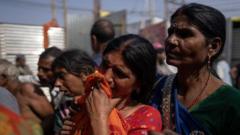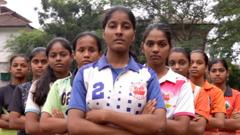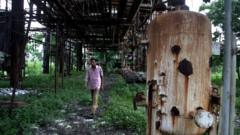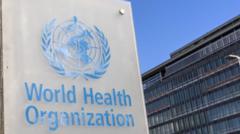Despite the increasing severity of air pollution across northern India, media attention continues to focus predominantly on Delhi. Residents in cities like Chandigarh and Meerut are suffering the consequences of toxic air, experiencing serious health issues and limited options for relief.
Smog Crisis in Northern India: The Hidden Toll Beyond Delhi
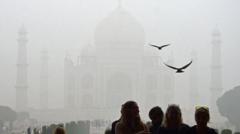
Smog Crisis in Northern India: The Hidden Toll Beyond Delhi
As smog blankets northern India, cities like Chandigarh and Meerut grapple with alarming pollution levels, yet remain overshadowed by Delhi's crisis.
In the northern Indian city of Chandigarh, lawyer Imran Ahmed Ali describes stepping outside as akin to inhaling smoke. Pollution levels in Chandigarh, roughly 240km from Delhi, have exceeded 15 times the safe limit set by the World Health Organization (WHO) for over a month. Winter is traditionally a challenging season for air quality here, but Ali has never experienced such severe symptoms before. He began suffering from a dry cough and shortness of breath, initially dismissing them as a cold until a doctor's visit revealed his symptoms were due to pollution.
Ali represents the millions exposed to hazardous air across northern India each winter. Data from Swiss firm IQAir highlights that eight of the world's ten most polluted cities last year were located in the Indo-Gangetic plains, a densely populated area of northern and eastern India along with parts of Pakistan and Nepal. A study from the Energy Policy Institute at the University of Chicago underscores that this region, containing over 540 million residents, is the most polluted in India, potentially reducing life expectancy by 5.4 years when compared to WHO standards.
While Delhi's pollution grab headlines largely due to its capital status, Partha Basu from the Environmental Defense Fund explains that this focus obscures the reality of other northeastern cities. Delhi does implement actions to combat pollution, such as seasonal driving restrictions and bans on construction during peak times. However, cities like Chandigarh and Meerut lack such proactive measures, leading to widespread health concerns that often go unreported.
Pollution in the region arises from multiple factors including construction, vehicular emissions, industrial waste, and the burning of crop residue. The situation worsens during winter as cold air traps pollutants near the ground. Health experts like Dr. Rajesh Gupta warn that respiratory issues often escalate at this time of year, affecting both healthy individuals and vulnerable groups like children and the elderly.
The bleak air quality has affected the routines of many. Aditi Garg, working in Meerut, now spends her mornings indoors next to an air purifier, unable to enjoy previous outdoor moments. Meanwhile, many residents, particularly low-income workers in Uttar Pradesh, have no choice but to endure the polluted air as they lack alternative employment.
Mohammed Salim Siddiqui, a vendor in Kanpur, describes the struggle to breathe outside and the toll on his family, highlighting the pressing need for assistance. Over the years, some state governments have attempted to address pollution through initiatives like the National Clean Air Programme (NCAP), which aims to reduce particulate matter, but experts contend that more robust action and better inter-governmental cooperation are essential for real change.
Basu identifies a crucial barrier to improvement as the inadequate conversation about pollution outside of Delhi. Residents like Ali express a resigned acceptance of poor air quality, suggesting the issue becomes an annual topic of discussion that fades from public consciousness until the smog returns.
Ali represents the millions exposed to hazardous air across northern India each winter. Data from Swiss firm IQAir highlights that eight of the world's ten most polluted cities last year were located in the Indo-Gangetic plains, a densely populated area of northern and eastern India along with parts of Pakistan and Nepal. A study from the Energy Policy Institute at the University of Chicago underscores that this region, containing over 540 million residents, is the most polluted in India, potentially reducing life expectancy by 5.4 years when compared to WHO standards.
While Delhi's pollution grab headlines largely due to its capital status, Partha Basu from the Environmental Defense Fund explains that this focus obscures the reality of other northeastern cities. Delhi does implement actions to combat pollution, such as seasonal driving restrictions and bans on construction during peak times. However, cities like Chandigarh and Meerut lack such proactive measures, leading to widespread health concerns that often go unreported.
Pollution in the region arises from multiple factors including construction, vehicular emissions, industrial waste, and the burning of crop residue. The situation worsens during winter as cold air traps pollutants near the ground. Health experts like Dr. Rajesh Gupta warn that respiratory issues often escalate at this time of year, affecting both healthy individuals and vulnerable groups like children and the elderly.
The bleak air quality has affected the routines of many. Aditi Garg, working in Meerut, now spends her mornings indoors next to an air purifier, unable to enjoy previous outdoor moments. Meanwhile, many residents, particularly low-income workers in Uttar Pradesh, have no choice but to endure the polluted air as they lack alternative employment.
Mohammed Salim Siddiqui, a vendor in Kanpur, describes the struggle to breathe outside and the toll on his family, highlighting the pressing need for assistance. Over the years, some state governments have attempted to address pollution through initiatives like the National Clean Air Programme (NCAP), which aims to reduce particulate matter, but experts contend that more robust action and better inter-governmental cooperation are essential for real change.
Basu identifies a crucial barrier to improvement as the inadequate conversation about pollution outside of Delhi. Residents like Ali express a resigned acceptance of poor air quality, suggesting the issue becomes an annual topic of discussion that fades from public consciousness until the smog returns.



